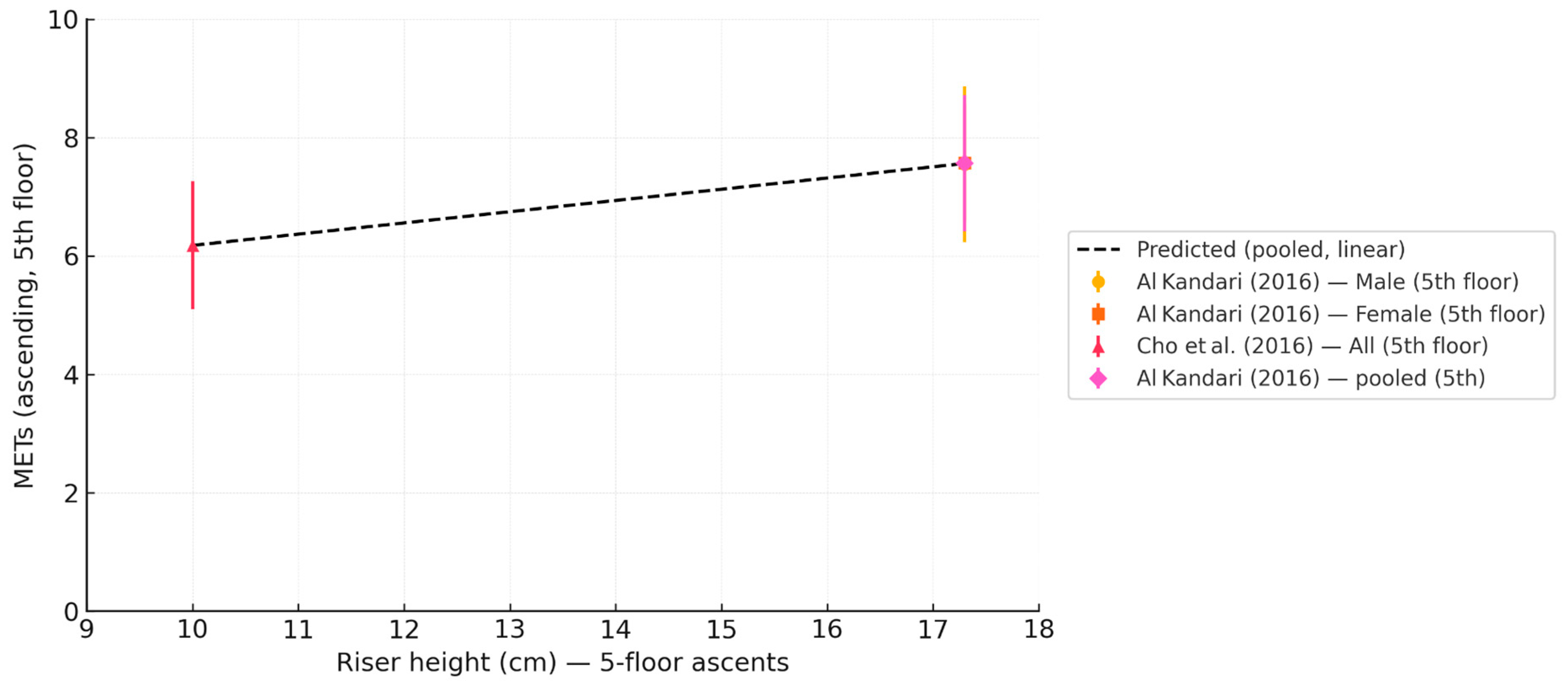Brain Booster Buildings: Modelling Stair Use as a Daily Booster of Brain-Derived Neurotrophic Factor
Abstract
1. Introduction
2. Materials and Methods
- Explore the associations between metabolic equivalents (METs) and both stairs and stair use parameters. This objective is accomplished through a narrative literature review using search terms ‘stair *’, ‘metabolic equivalents’, and METs in the Scopus database and Google Scholar for studies published between 1995 and 2025. We only included English-language studies on healthy adults to avoid any confounding variables at this stage. Studies must report acute METs explicitly, and with objective measures. They must report the number of flights or floors if not reporting METs associated with carrying loads upstairs. The first objective is to establish an association between the predictive outcome of METs and both staircase parameters (e.g., number of floors) and stair use type (e.g., ascending stairs, descending stairs, or both).
- Explain the potential association between staircase parameters (e.g., number of floors and riser height) and the METs outcome to inform architectural design.
- Explore the association between physical activity intensities (low intensity < 3 METs, moderate intensity = 3–6 METs, and high intensity > 6 METs) and acute changes in BDNF levels. Due to the lack of meta-analyses, this objective was achieved through a narrative review of the acute changes in BDNF in response to different types of activity.
- Establish the ‘Brain Booster Buildings’ theoretical framework that can estimate increases in BDNF levels according to the recommended duration of stair use to inform policymakers and lifestyle medicine.
- Conduct scenario-based modelling using the Brain Booster Buildings framework to estimate the BDNF changes in three scenarios (1, 3, and >3 floors) for each building type (residential, educational, office, hospital, and commercial).
3. Staircase Affordances for Metabolic Equivalents (METs)
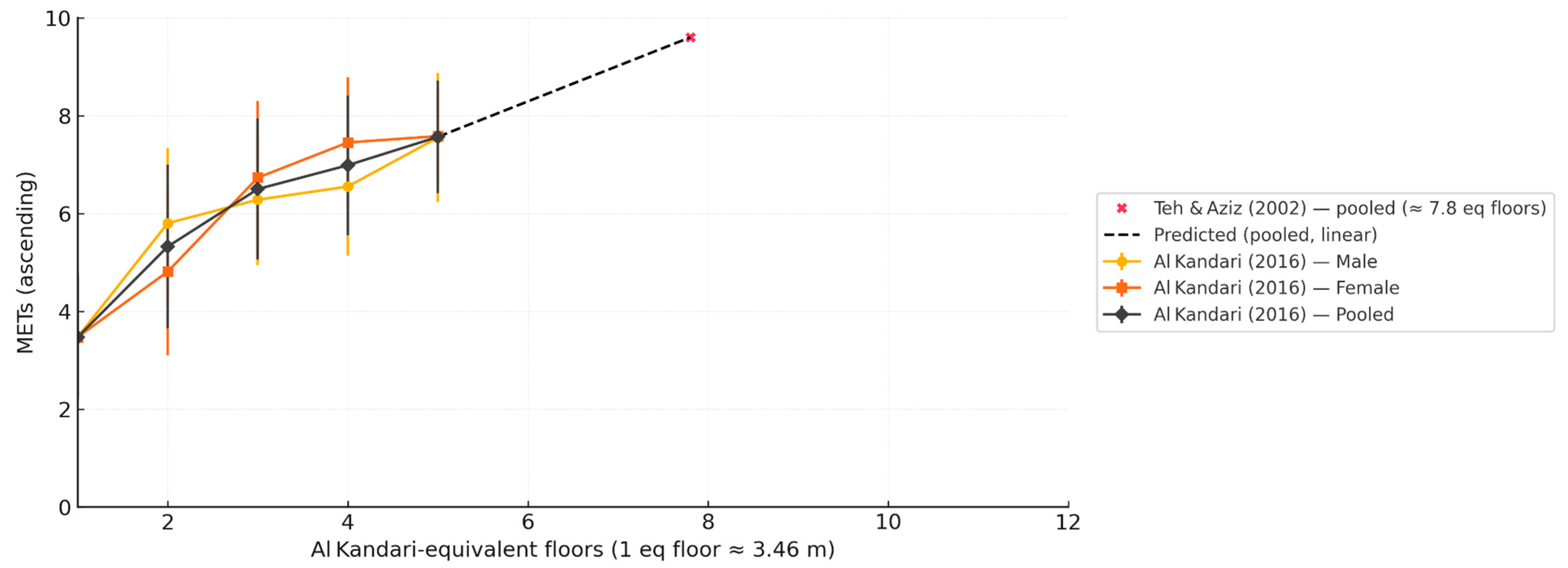
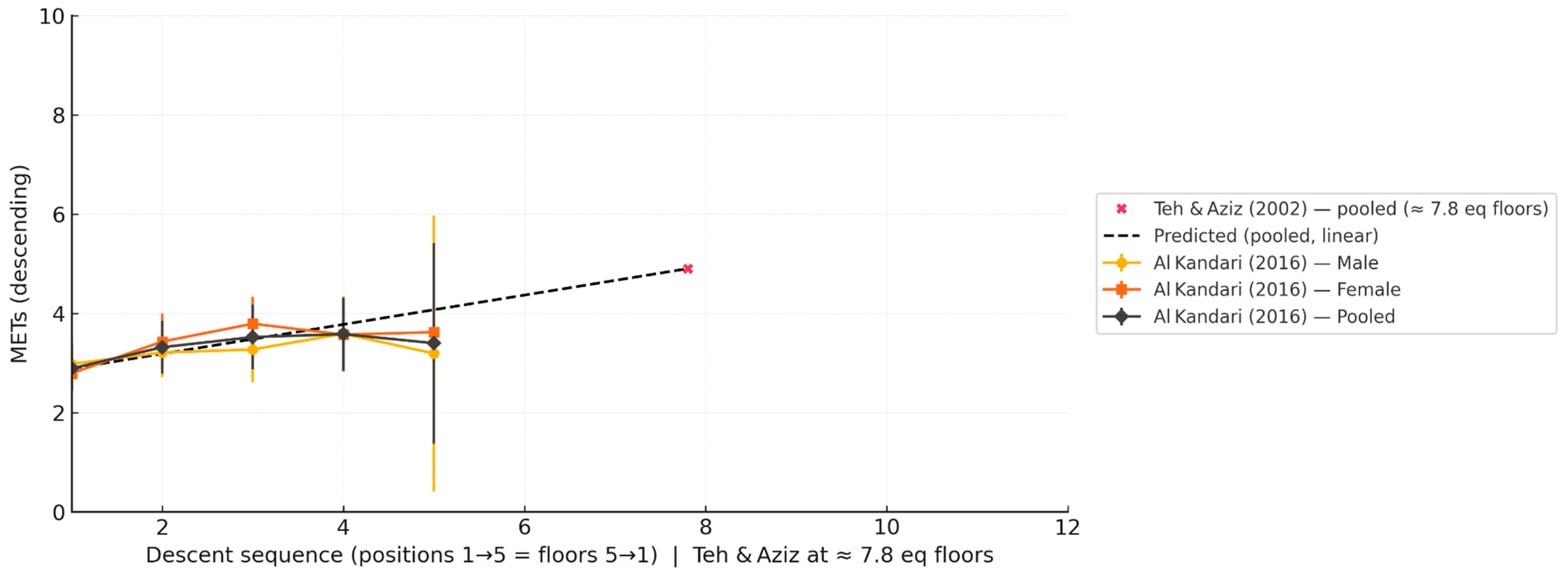
| Subject Physical Characteristics | Stairs Characteristics | Stair Use | Total Duration | METs | ||||||
|---|---|---|---|---|---|---|---|---|---|---|
| Age | Weight (kg) | Height (m) | Pace (Steps·Min−1) | Riser Height (cm) | Total Steps | Floors/Flights (Above Ground) | ||||
| Staircase | ||||||||||
| Teh & Aziz [36] | M: 44.8 ± 13.9 F: 43.2 ± 12.9 | M: 66.2 ± 10.6 F: 54.4 ± 7.2 | M: 1.68 ± 0.5 F: 1.58 ± 0.5 | Brisk pace - Ascent: M: 99 ± 14 F: 90 ± 14 Descent: M: 103 ± 9 F: 110 ± 17 | 15 | 180 | 11 floors (22 flights) | Ascent and descent | Ascent: 116 ± 18 s Descent: 106 ± 14 s | Ascent: M: 9.9 F: 9.2 Descent: M: 4.6 F: 5.1 |
| Yue et al. [39] | Young adults M: 28.7 ± 7.5 F: 25.9 ± 7.7 Older adults M: 72.7 ± 7.1 F: 71.1 ± 6.0 | Young adults M: 63.2 ± 9.2 F: 54.6 ± 9.9 Older adults M: 63.7 ± 8.0 F: 56.4 ± 8.4 | Young adults M: 1.72 ± 0.08 F: 1.58 ± 0.08 Older adults M: 1.64 ± 0.06 F: 1.52 ± 0.05 | Preferred or normal speed | — | — | 2 flights | Ascent and descent × 4 times | (Ascent and descent) Young adults: 1.96 ± 0.29 min Older adults: 2.96 ± 0.14 min | (Ascent and descent) Young adults: 3.8 ± 0.69 Older adults: 2.9 ± 0.73 |
| Cho et al. [37] | 31.0 ± 4.9 | 67.9 ± 12.9 | 169.3 ± 6.9 | Railing use is allowed | 10 | — | 5 floors | Ascent | — | 6.18 ± 1.08 |
| Al Kandari et al. [38] | M: 33.6 ± 10.53 F: 30.93 ± 19.69 | M: 82.27 ± 13.04 F: 67.93 ± 10.99 | M: 1.72 ± 0.05 F: 1.59 ± 0.08 | Natural pace | 17.3 | 100 | 5 floors (est. 10 flights) | Ascent and descent | Ascent: 2 min Descent: 2 min | Ascent: M: 7.55 ± 1.32 F: 7.58 ± 0.99 Descent: M: 3.19 ± 2.78 F: 3.62 ± 0.61 |
4. Physical Activity, METs and BDNF
| Study | Sample Size (Young Adults up to 35 yrs) | Sample Characteristics | BDNF (Serum/Plasma) | PA Intensity and Duration | Delta (BDNF Δ (Baseline → Final)—Moderate Intensity (3–6 METs) | Delta (BDNF Δ (Baseline → Final)—High Intensity (>6 METs) |
|---|---|---|---|---|---|---|
| Within-person | ||||||
| Gibbons et al. [48] | 12 (6 males; 6 females) | Aerobically fit and healthy; 30 ± 10 years; BMI < 25 | Plasma and serum | 90 min light-intensity + 6 min high-intensity | — | Plasma = +250% Serum = +40% |
| Marquez et al. [50] | 26 males | Active and healthy; 28 ± 5 years; | serum | — | — | HIIT: 0 → 6 min: ~+900 pg/mL 0 → 20 min: ~+3900 pg/mL Cont.: 0 → 6 min: ~+1700 pg/mL 0 → 20 min: ~+1800 pg/mL |
| Between-person | ||||||
| Hutchinson et al. [42] | 30 females | 30.2 ± 4.3 years; BMI 18.5–29.9 | serum | Moderate intensity walking 40–60% heart rate reserve (HRR) for 30 min (excluding 2 min. warmup | ~+300 pg/mL (pregnant women) ~+1700 pg/mL (non-pregnant women) | — |
| Goulet et al. [51] | 13 males | Active and healthy; 22 ± 3 years; 79.2 (9.3) kg | serum | 180 min. Moderate intensity walking (in a 32 °C environment) | ~+1000 pg/mL (similarly in the old adults group) | — |
5. The Brain Booster Buildings: A Theoretical Framework
6. Discussion
7. Conclusions
Author Contributions
Funding
Data Availability Statement
Acknowledgments
Conflicts of Interest
References
- Martinowich, K.; Lu, B. Interaction between BDNF and serotonin: Role in mood disorders. Neuropsychopharmacology 2008, 33, 73–83. [Google Scholar] [CrossRef] [PubMed]
- Polyakova, M.; Stuke, K.; Schuemberg, K.; Mueller, K.; Schoenknecht, P.; Schroeter, M.L. BDNF as a biomarker for successful treatment of mood disorders: A systematic & quantitative meta-analysis. J. Affect. Disord. 2015, 174, 432–440. [Google Scholar] [CrossRef] [PubMed]
- Jin, Y.; Sun, L.H.; Yang, W.; Cui, R.J.; Xu, S.B. The role of BDNF in the neuroimmune axis regulation of mood disorders. Front. Neurol. 2019, 10, 515. [Google Scholar] [CrossRef] [PubMed]
- Taliaz, D.; Loya, A.; Gersner, R.; Haramati, S.; Chen, A.; Zangen, A. Resilience to chronic stress is mediated by hippocampal brain-derived neurotrophic factor. J. Neurosci. 2011, 31, 4475–4483. [Google Scholar] [CrossRef]
- Leschik, J.; Gentile, A.; Cicek, C.; Péron, S.; Tevosian, M.; Beer, A.; Radyushkin, K.; Bludau, A.; Ebner, K.; Neumann, I.; et al. Brain-derived neurotrophic factor expression in serotonergic neurons improves stress resilience and promotes adult hippocampal neurogenesis. Prog. Neurobiol. 2022, 217, 102333. [Google Scholar] [CrossRef]
- Ihara, K.; Yoshida, H.; Jones, P.B.; Hashizume, M.; Suzuki, Y.; Ishijima, H.; Kim, H.K.; Suzuki, T.; Hachisu, M. Serum BDNF levels before and after the development of mood disorders: A case–control study in a population cohort. Transl. Psychiatry 2016, 6, e782. [Google Scholar] [CrossRef]
- Bekinschtein, P.; Oomen, C.A.; Saksida, L.M.; Bussey, T.J. Effects of environmental enrichment and voluntary exercise on neurogenesis, learning and memory, and pattern separation: BDNF as a critical variable? In Seminars in Cell & Developmental Biology; Academic Press: Cambridge, MA, USA, 2011; Volume 22, pp. 536–542. [Google Scholar]
- Li, Y.; Li, F.; Qin, D.; Chen, H.; Wang, J.; Wang, J.; Song, S.; Wang, C.; Wang, Y.; Liu, S.; et al. The role of brain derived neurotrophic factor in central nervous system. Front. Aging Neurosci. 2022, 14, 986443. [Google Scholar] [CrossRef]
- Chen, S.-D.; Wu, C.-L.; Hwang, W.-C.; Yang, D.-I. More insight into BDNF against neurodegeneration: Anti-apoptosis, anti-oxidation, and suppression of autophagy. Int. J. Mol. Sci. 2017, 18, 545. [Google Scholar] [CrossRef]
- Sahay, A.; Scobie, K.N.; Hill, A.S.; O’Carroll, C.M.; Kheirbek, M.A.; Burghardt, N.S.; Fenton, A.A.; Dranovsky, A.; Hen, R. Increasing adult hippocampal neurogenesis is sufficient to improve pattern separation. Nature 2011, 472, 466–470. [Google Scholar] [CrossRef]
- Toda, T.; Parylak, S.L.; Linker, S.B.; Gage, F.H. The role of adult hippocampal neurogenesis in brain health and disease. Mol. Psychiatry 2019, 24, 67–87. [Google Scholar] [CrossRef]
- Azevedo, K.P.M.d.; de Oliveira, V.H.; Medeiros, G.C.B.S.d.; Mata, Á.N.d.S.; García, D.Á.; Martínez, D.G.; Leitão, J.C.; Knackfuss, M.I.; Piuvezam, G. The effects of exercise on BDNF levels in adolescents: A systematic review with meta-analysis. Int. J. Environ. Res. Public Health 2020, 17, 6056. [Google Scholar] [CrossRef]
- Fernández-Rodríguez, R.; Alvarez-Bueno, C.; Martínez-Ortega, I.A.; Martínez-Vizcaíno, V.; Mesas, A.E.; Notario-Pacheco, B. Immediate effect of high-intensity exercise on brain-derived neurotrophic factor in healthy young adults: A systematic review and meta-analysis. J. Sport Health Sci. 2022, 11, 367–375. [Google Scholar] [CrossRef]
- Khalil, M.H. The Impact of Walking on BDNF as a Biomarker of Neuroplasticity: A Systematic Review. Brain Sci. 2025, 15, 254. [Google Scholar] [CrossRef]
- Feter, N.; Alt, R.; Dias, M.G.; Rombaldi, A.J. How do different physical exercise parameters modulate brain-derived neurotrophic factor in healthy and non-healthy adults? A systematic review, meta-analysis and meta-regression. Sci. Sports 2019, 34, 293–304. [Google Scholar] [CrossRef]
- Khalil, M.H. The BDNF-interactive model for sustainable hippocampal neurogenesis in humans: Synergistic effects of environmentally-mediated physical activity, cognitive stimulation, and mindfulness. Int. J. Mol. Sci. 2024, 25, 12924. [Google Scholar] [CrossRef]
- Liu, P.Z.; Nusslock, R. Exercise-mediated neurogenesis in the hippocampus via BDNF. Front. Neurosci. 2018, 12, 52. [Google Scholar] [CrossRef] [PubMed]
- Rossi, C.; Angelucci, A.; Costantin, L.; Braschi, C.; Mazzantini, M.; Babbini, F.; Fabbri, M.E.; Tessarollo, L.; Maffei, L.; Berardi, N.; et al. Brain-derived neurotrophic factor (BDNF) is required for the enhancement of hippocampal neurogenesis following environmental enrichment. Eur. J. Neurosci. 2006, 24, 1850–1856. [Google Scholar] [CrossRef] [PubMed]
- Ribeiro, D.; Petrigna, L.; Pereira, F.C.; Muscella, A.; Bianco, A.; Tavares, P. The impact of physical exercise on the circulating levels of BDNF and NT 4/5: A review. Int. J. Mol. Sci. 2021, 22, 8814. [Google Scholar] [CrossRef]
- Moreno-Jiménez, E.P.; Flor-García, M.; Terreros-Roncal, J.; Rábano, A.; Cafini, F.; Pallas-Bazarra, N.; Ávila, J.; Llorens-Martín, M. Adult hippocampal neurogenesis is abundant in neurologically healthy subjects and drops sharply in patients with Alzheimer’s disease. Nat. Med. 2019, 25, 554–560. [Google Scholar] [CrossRef] [PubMed]
- Moreno-Jiménez, E.P.; Terreros-Roncal, J.; Flor-García, M.; Rábano, A.; Llorens-Martín, M. Evidences for adult hippocampal neurogenesis in humans. J. Neurosci. 2021, 41, 2541–2553. [Google Scholar] [CrossRef]
- Tobin, M.K.; Musaraca, K.; Disouky, A.; Shetti, A.; Bheri, A.; Honer, W.G.; Kim, N.; Dawe, R.J.; Bennett, D.A.; Arfanakis, K.; et al. Human hippocampal neurogenesis persists in aged adults and Alzheimer’s disease patients. Cell Stem Cell 2019, 24, 974–982. [Google Scholar] [CrossRef]
- Boldrini, M.; Fulmore, C.A.; Tartt, A.N.; Simeon, L.R.; Pavlova, I.; Poposka, V.; Rosoklija, G.B.; Stankov, A.; Arango, V.; Dwork, A.J.; et al. Human hippocampal neurogenesis persists throughout aging. Cell Stem Cell 2018, 22, 589–599. [Google Scholar] [CrossRef]
- Spalding, K.L.; Bergmann, O.; Alkass, K.; Bernard, S.; Salehpour, M.; Huttner, H.B.; Boström, E.; Westerlund, I.; Vial, C.; Buchholz, B.A.; et al. Dynamics of hippocampal neurogenesis in adult humans. Cell 2013, 153, 1219–1227. [Google Scholar] [CrossRef]
- Herrmann, S.D.; Willis, E.A.; Ainsworth, B.E.; Barreira, T.V.; Hastert, M.; Kracht, C.L.; Schuna, J.M.; Cai, Z.; Quan, M.; Tudor-Locke, C.; et al. 2024 Adult Compendium of Physical Activities: A third update of the energy costs of human activities. J. Sport Health Sci. 2024, 13, 6–12. [Google Scholar] [CrossRef] [PubMed]
- Khalil, M.H. Urban physical activity for neurogenesis: Infrastructure limitations. Front. Public Health 2025, 13, 1638934. [Google Scholar] [CrossRef] [PubMed]
- Bos, I.; Jacobs, L.; Nawrot, T.; de Geus, B.; Torfs, R.; Panis, L.I.; Degraeuwe, B.; Meeusen, R. No exercise-induced increase in serum BDNF after cycling near a major traffic road. Neurosci. Lett. 2011, 500, 129–132. [Google Scholar] [CrossRef]
- Klepeis, N.E.; Nelson, W.C.; Ott, W.R.; Robinson, J.P.; Tsang, A.M.; Switzer, P.; Behar, J.V.; Hern, S.C.; Engelmann, W.H. The National Human Activity Pattern Survey (NHAPS): A resource for assessing exposure to environmental pollutants. J. Expo. Sci. Environ. Epidemiol. 2001, 11, 231–252. [Google Scholar] [CrossRef]
- Sharkey, P. Homebound: The long-term rise in time spent at home among US adults. Sociol. Sci. 2024, 11, 553–578. [Google Scholar] [CrossRef]
- Shi, H.; Goulias, K.G. Long-term effects of COVID-19 on time allocation, travel behavior, and shopping habits in the United States. J. Transp. Health 2024, 34, 101730. [Google Scholar] [CrossRef]
- Morris, E.A.; Speroni, S.; Taylor, B.D. Going nowhere faster: Did the COVID-19 pandemic accelerate the trend toward staying home? J. Am. Plan. Assoc. 2025, 91, 361–379. [Google Scholar] [CrossRef]
- Khalil, M.H. Environmental affordance for physical activity, neurosustainability, and brain health: Quantifying the built environment’s ability to sustain BDNF release by reaching metabolic equivalents (METs). Brain Sci. 2024, 14, 1133. [Google Scholar] [CrossRef]
- Park, S.A.; Lee, A.Y.; Park, H.G.; Lee, W.L. Benefits of gardening activities for cognitive function according to measurement of brain nerve growth factor levels. Int. J. Environ. Res. Public Health 2019, 16, 760. [Google Scholar] [CrossRef]
- Willis, E.A.; Herrmann, S.D.; Hastert, M.; Kracht, C.L.; Barreira, T.V.; Schuna, J.M.; Cai, Z.; Quan, M.; Conger, S.A.; Brown, W.J.; et al. Older Adult Compendium of Physical Activities: Energy costs of human activities in adults aged 60 and older. J. Sport Health Sci. 2024, 13, 13–17. [Google Scholar] [CrossRef]
- Bull, F.C.; Al-Ansari, S.S.; Biddle, S.; Borodulin, K.; Buman, M.P.; Cardon, G.; Chaput, J.-P.; Chastin, S.; Chou, R.; Dempsey, P.C.; et al. World Health Organization 2020 guidelines on physical activity and sedentary behaviour. Br. J. Sports Med. 2020, 54, 1451–1462. [Google Scholar] [CrossRef] [PubMed]
- Teh, K.C.; Aziz, A.R. Heart rate, oxygen uptake, and energy cost of ascending and descending the stairs. Med. Sci. Sports Exerc. 2002, 34, 695–699. [Google Scholar]
- Cho, K.H.; Song, W.; Kim, J.; Jung, E.J.; Jang, J.; Im, S.H.; Kim, M. Energy expenditures for activities of daily living in Korean young adults: A preliminary study. Ann. Rehabil. Med. 2016, 40, 725–733. [Google Scholar] [CrossRef] [PubMed]
- Al Kandari, J.R.; Mohammad, S.; Al-Hashem, R.; Telahoun, G.; Barac-Nieto, M. Practical use of stairs to assess fitness, prescribe and perform physical activity training. Health 2016, 8, 1402–1410. [Google Scholar] [CrossRef]
- Yue, A.S.; Woo, J.; Ip, K.W.; Sum, C.M.; Kwok, T.; Hui, S.S. Effect of age and gender on energy expenditure in common activities of daily living in a Chinese population. Disabil. Rehabil. 2007, 29, 91–96. [Google Scholar] [CrossRef]
- Norton, K.; Norton, L.; Sadgrove, D. Position statement on physical activity and exercise intensity terminology. J. Sci. Med. Sport 2010, 13, 496–502. [Google Scholar] [CrossRef]
- Ramos, J.S.; Dalleck, L.C.; Tjonna, A.E.; Beetham, K.S.; Coombes, J.S. The impact of high-intensity interval training versus moderate-intensity continuous training on vascular function: A systematic review and meta-analysis. Sports Med. 2015, 45, 679–692. [Google Scholar] [CrossRef] [PubMed]
- Hutchinson, K.A.; Mohammad, S.; Garneau, L.; McInnis, K.; Aguer, C.; Adamo, K.B. Examination of the myokine response in pregnant and non-pregnant women following an acute bout of moderate-intensity walking. Front. Physiol. 2019, 10, 1188. [Google Scholar] [CrossRef]
- Kettinen, J.; Tikkanen, H.; Hiltunen, M.; Murray, A.; Horn, N.; Taylor, W.R.; Venojärvi, M. Cognitive and biomarker responses in healthy older adults to a 18-hole golf round and different walking types: A randomised cross-over study. BMJ Open Sport Exerc. Med. 2023, 9, e001629. [Google Scholar] [CrossRef] [PubMed]
- Yasuoka, Y.; Nakamura, T.; Umemoto, Y.; Kinoshita, T.; Hoekstra, S.P.; Hoshiai, K.; Ohko, H.; Abo, M.; Tajima, F. An 18-hole round of golf acutely elevates serum Interleukin-6 and brain-derived neurotrophic factor concentration-a pilot study. J. Phys. Fit. Sports Med. 2022, 11, 1–7. [Google Scholar] [CrossRef]
- Weston, K.S.; Wisløff, U.; Coombes, J.S. High-intensity interval training in patients with lifestyle-induced cardiometabolic disease: A systematic review and meta-analysis. Br. J. Sports Med. 2014, 48, 1227–1234. [Google Scholar] [CrossRef]
- Buchheit, M.; Laursen, P.B. High-intensity interval training, solutions to the programming puzzle: Part I: Cardiopulmonary emphasis. Sports Med. 2013, 43, 313–338. [Google Scholar] [CrossRef]
- Lasso-Quilindo, C.A.; Chalapud-Narvaez, L.M.; Garcia-Chaves, D.C.; Cristi-Montero, C.; Yañez-Sepulveda, R. Effect of 4 Weeks of High-Intensity Interval Training (HIIT) on VO2max, Anaerobic Power, and Specific Performance in Cyclists with Cerebral Palsy. J. Funct. Morphol. Kinesiol. 2025, 10, 102. [Google Scholar] [CrossRef] [PubMed]
- Gibbons, T.D.; Cotter, J.D.; Ainslie, P.N.; Abraham, W.C.; Mockett, B.G.; Campbell, H.A.; Jones, E.M.W.; Jenkins, E.J.; Thomas, K.N. Fasting for 20 h does not affect exercise-induced increases in circulating BDNF in humans. J. Physiol. 2023, 601, 2121–2137. [Google Scholar] [CrossRef]
- Li, Q.; Zhang, L.; Zhang, Z.; Wang, Y.; Zuo, C.; Bo, S. A shorter-bout of HIIT is more effective to promote serum BDNF and VEGF-A levels and improve cognitive function in healthy young men. Front. Physiol. 2022, 13, 898603. [Google Scholar] [CrossRef]
- Marquez, C.M.S.; Vanaudenaerde, B.; Troosters, T.; Wenderoth, N. High-intensity interval training evokes larger serum BDNF levels compared with intense continuous exercise. J. Appl. Physiol. 2015, 119, 1363–1373. [Google Scholar] [CrossRef]
- Goulet, N.; McCormick, J.J.; King, K.E.; Notley, S.R.; Goldfield, G.S.; Fujii, N.; Amano, T.; Kenny, G.P. Elevations in serum brain-derived neurotrophic factor following occupational heat stress are not influenced by age or common chronic disease. Temperature 2023, 10, 454–464. [Google Scholar] [CrossRef]
- Li, Y.; Liu, J.; Quan, M.; Zhuang, J.; Cao, Z.-B.; Zhu, Z.; Li, Y.; Herrmann, S.D.; Ainsworth, B.E. Energy costs of household and eldercare activities in young to middle-aged Chinese adults. J. Phys. Act. Health 2022, 19, 404–408. [Google Scholar] [CrossRef] [PubMed]
- Michael, E.; White, M.J.; Eves, F.F. Home-based stair climbing as an intervention for disease risk in adult females; a controlled study. Int. J. Environ. Res. Public Health 2021, 18, 603. [Google Scholar] [CrossRef] [PubMed]
- Sanchez-Lastra, M.A.; Ding, D.; Dalene, K.E.; del Pozo Cruz, B.; Ekelund, U.; Tarp, J. Stair climbing and mortality: A prospective cohort study from the UK Biobank. J. Cachexia Sarcopenia Muscle 2021, 12, 298–307. [Google Scholar] [CrossRef]
- Song, Z.; Wan, L.; Wang, W.; Li, Y.; Zhao, Y.; Zhuang, Z.; Dong, X.; Xiao, W.; Huang, N.; Xu, M.; et al. Daily stair climbing, disease susceptibility, and risk of atherosclerotic cardiovascular disease: A prospective cohort study. Atherosclerosis 2023, 386, 117300. [Google Scholar] [CrossRef]
- British Heart Foundation. Staying Active. Available online: https://www.bhf.org.uk/informationsupport/support/healthy-living/staying-active#:~:text=It’s%20recommended%20that%20you%20do,when%20running%2C%20swimming%20or%20cycling (accessed on 9 June 2025).
- National Health Service. Physical Activity Guidelines for Adults Aged 19 to 64. 2024. Available online: https://www.nhs.uk/live-well/exercise/physical-activity-guidelines-for-adults-aged-19-to-64/#:~:text=In%20general%2C%2075%20minutes%20of,running (accessed on 9 June 2025).
- American College of Sports Medicine. ACSM’s Guidelines for Exercise Testing and Prescription, 12th ed.; Lippincott Williams & Wilkins: Philadelphia, PA, USA, 2025. [Google Scholar]
- Baker, N.; Steemers, K. Healthy Homes: Designing with Light and Air for Sustainability and Wellbeing; Riba Publishing: London, UK, 2019. [Google Scholar]
- Khalil, M.H.; Steemers, K. Housing environmental enrichment, lifestyles, and public health indicators of neurogenesis in humans: A pilot study. Int. J. Environ. Res. Public Health 2024, 21, 1553. [Google Scholar] [CrossRef]
- McCormick, B.P.; Brusilovskiy, E.; Snethen, G.; Klein, L.; Townley, G.; Salzer, M.S. Getting out of the house: The relationship of venturing into the community and neurocognition among adults with serious mental illness. Psychiatr. Rehabil. J. 2022, 45, 18. [Google Scholar] [CrossRef]
- Stork, M.J.; Marcotte-Chénard, A.; Jung, M.E.; Little, J.P. Exercise in the workplace: Examining the receptivity of practical and time-efficient stair-climbing “exercise snacks”. Appl. Physiol. Nutr. Metab. 2023, 49, 30–40. [Google Scholar] [CrossRef] [PubMed]
- Weston, K.L.; Little, J.P.; Weston, M.; McCreary, S.; Kitchin, V.; Gill, A.; Niven, A.; McNarry, M.A.; Mackintosh, K.A. Application of exercise snacks across youth, adult and clinical populations: A scoping review. Sports Med.-Open 2025, 11, 27. [Google Scholar] [CrossRef]
- Islam, H.; Gibala, M.J.; Little, J.P. Exercise snacks: A novel strategy to improve cardiometabolic health. Exerc. Sport Sci. Rev. 2022, 50, 31–37. [Google Scholar] [CrossRef]
- Jones, M.D.; Clifford, B.K.; Stamatakis, E.; Gibbs, M.T. Exercise snacks and other forms of intermittent physical activity for improving health in adults and older adults: A scoping review of epidemiological, experimental and qualitative studies. Sports Med. 2024, 54, 813–835. [Google Scholar] [CrossRef]
- Yin, M.; Zheng, H.; Bai, M.; Huang, G.; Chen, Z.; Deng, S.; Lyu, M.; Deng, J.; Zhang, B.; Li, H.; et al. Effects of Integrating Stair Climbing-Based Exercise Snacks Into the Campus on Feasibility, Perceived Efficacy, and Participation Perspectives in Inactive Young Adults: A Randomized Mixed-Methods Pilot Study. Scand. J. Med. Sci. Sports 2024, 34, e14771. [Google Scholar] [CrossRef]
- Jenkins, E.M.; Nairn, L.N.; Skelly, L.E.; Little, J.P.; Gibala, M.J. Do stair climbing exercise “snacks” improve cardiorespiratory fitness? Appl. Physiol. Nutr. Metab. 2019, 44, 681–684. [Google Scholar] [CrossRef] [PubMed]
- Blake, H.; Lee, S.; Stanton, T.; Gorely, T. Workplace intervention to promote stair-use in an NHS setting. Int. J. Workplace Health Manag. 2008, 1, 162–175. [Google Scholar] [CrossRef]
- Jude, E.B.; Purohit, A.; Puri, S.; Heald, A.H.; Tentolouris, N. Stairway to health: Stair vs. elevator usage and its impact on the health of NHS Staff. J. Public Health 2025, 1–6. [Google Scholar] [CrossRef]
- Tzikas, A.; Koulierakis, G.; Athanasakis, K.; Merakou, K. Nudging Hospital Visitors Towards Stair Use, in Greece. J. Prev. 2025, 46, 189–199. [Google Scholar] [CrossRef]
- Bachert, P.; Hildebrand, C.; Erley, N.; Jekauc, D.; Wäsche, H.; Kunkel, J.; Woll, A. Students on stairs: A participatory approach using decisional cues in the form of motivational signs to promote stair use. J. Am. Coll. Health 2022, 70, 2152–2158. [Google Scholar] [CrossRef]
- Berardi, V.; Rosenberg, B.D.; Srivastava, S.; Estrada-Rand, N.; Frederick, J. Stair versus elevator use in a university residence hall setting. J. Am. Coll. Health 2023, 71, 997–1002. [Google Scholar] [CrossRef]
- Jennings, C.A.; Yun, L.; Loitz, C.C.; Lee, E.Y.; Mummery, W.K. A systematic review of interventions to increase stair use. Am. J. Prev. Med. 2017, 52, 106–114. [Google Scholar] [CrossRef] [PubMed]
- Mustafa, F.A.; Ali, J.S. Active Design: Architectural Interventions for Improving Occupational Health Through Reducing Sedentary Behavior-A Systematic Review. Am. J. Health Promot. 2023, 37, 93–102. [Google Scholar] [CrossRef] [PubMed]
- Crozier, A.J. Step up: Exploring the impact of social prompts on stair use in a university setting. Psychol. Sport Exerc. 2019, 41, 99–106. [Google Scholar] [CrossRef]
- Caputo, E.L.; Feter, N.; Alt, R.; da Silva, M.C. How do different interventions impact stair climbing? A systematic review and meta-analysis. Glob. Health Promot. 2022, 29, 74–82. [Google Scholar] [CrossRef] [PubMed]

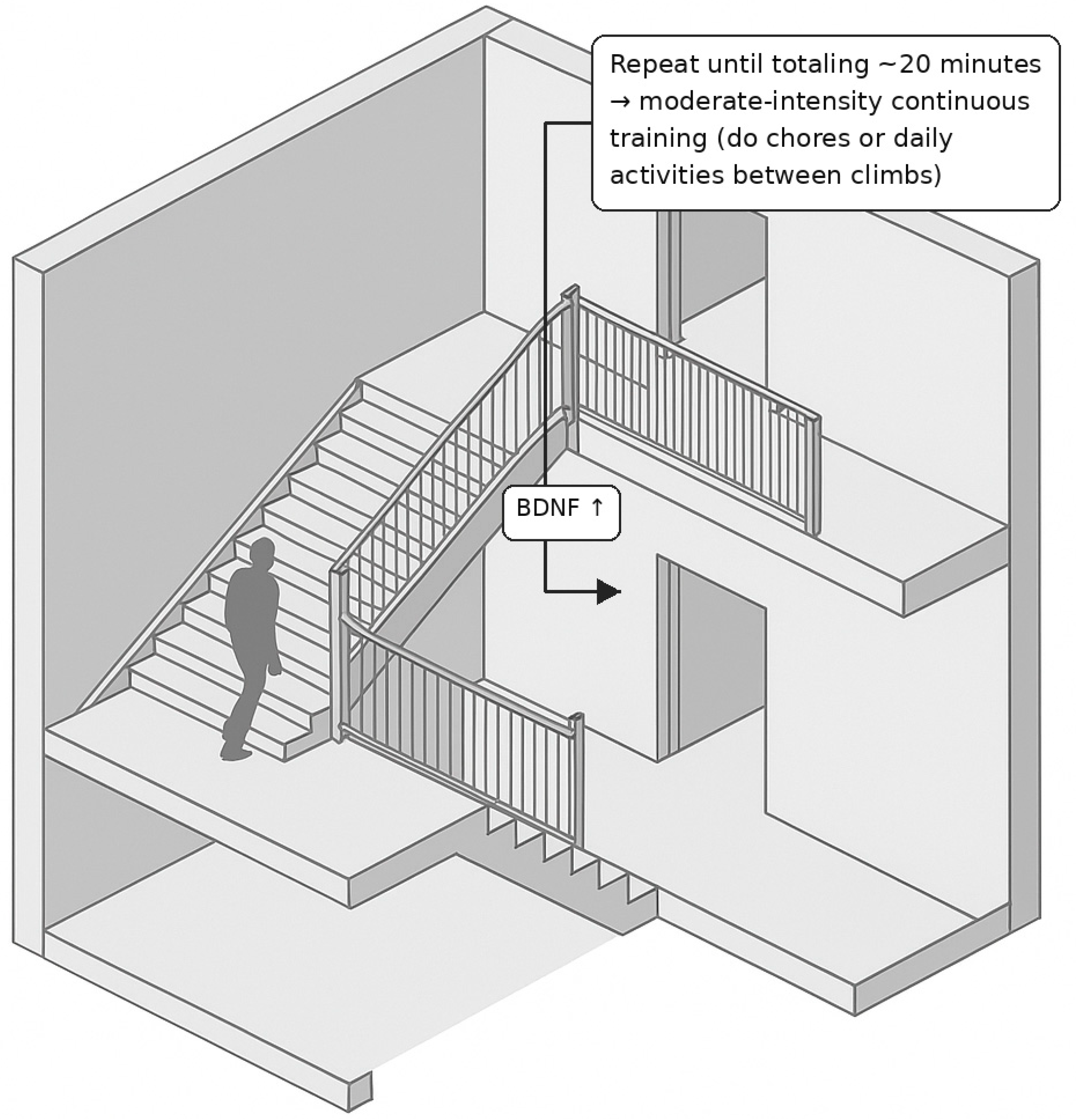
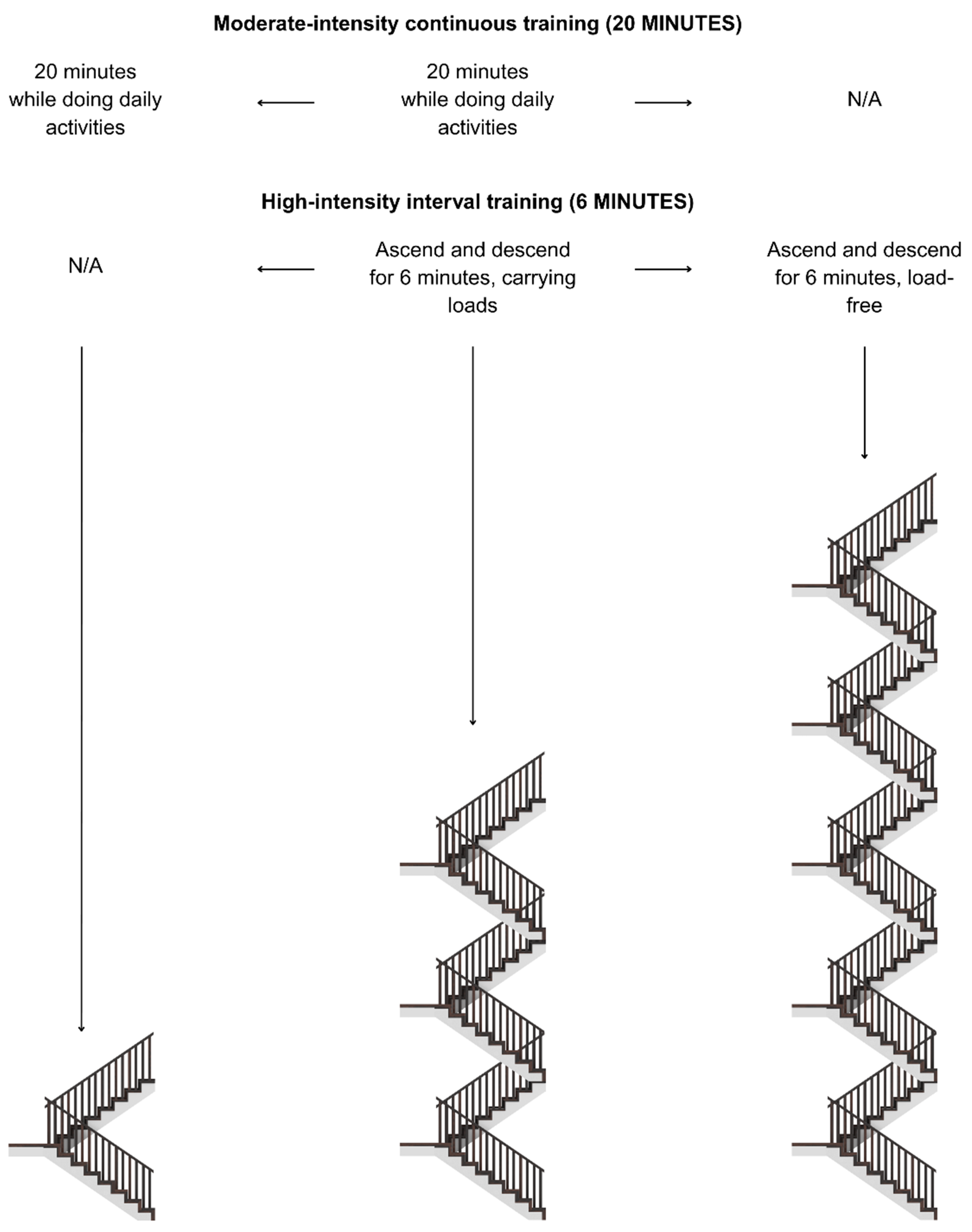
| Stair-Use Activity Type | Stair-Use Duration | Number of Floors for the Stair-Use Activity Type | Estimated BDNF Δ (in Blood Serum) * |
|---|---|---|---|
| MICE | ≥20 min | Continuously ascend and descend 1–3 floors while performing daily chores. | ~+1000 to 1700 pg/mL (20 min) |
| HIIT | 6–20 min | Ascend < 3 stories while carrying loads (e.g., boxes, bags) or ≥ 3 floors without carrying, descend load-free, and repeat. | ~+900 pg/mL (6 min) ~+3900 to 5370 pg/mL (20 min) |
| Residential Building | Spatial Activity Pattern Example | Duration and Components | Activity Type | Brain Boosting Opportunity |
|---|---|---|---|---|
| 1 floor (e.g., Bungalow) | Walking within home. | — | Light intensity | Risk factor if relying on the building to boost BDNF. No vertical structure + limited horizontal space. |
| 2 floors (e.g., ground + basement) | Performing laundry or daily chores: 10 trips up/down stairs over 20 min while sorting, loading, and folding clothes, or cleaning the house. | ≥20 min stairs use (continuous while performing activities). | MICE | Basement stairs provide minimal but sufficient vertical infrastructure to use when combined with daily activities. |
| 3 floors (e.g., townhouse, standalone) | (a) Morning routine: bedroom (3rd) → kitchen (2nd) → garage (1st) repeated during chores, meal preparation. (b) Carrying groceries or boxes upstairs. | (a) ≥20 min stairs use (continuous while performing activities). (b) 6 min stairs use while carrying loads. | (a) MICE (b) HIIT | Natural circulation integrates the stairs-based BDNF-boosting activity into daily routines. |
| >3 floors (apartment building) | Taking groceries/packages from the lobby to a high-floor apartment, 2–3 trips. | 6 min stair use while carrying loads. | HIIT | High capacity but elevator competition reduces actual use. |
| Office Building | Spatial Activity Pattern Example | Duration and Components | Activity Type | Brain Boosting Opportunity |
|---|---|---|---|---|
| 1 floor | Walking to printer, break room, colleague’s desk, restroom, parking lot. | — | Light intensity | The 1-storey office layout allows movement but intensity is too low. |
| 3 floors | (a) Employee stairs for meetings: 1st floor office → 3rd floor conference → 2nd floor colleague, 3–4 times/day. (b) Carrying boxes/packages upstairs. | (a) — (b) 6 min stair use while carrying loads | (a) Light intensity (b) HIIT | (a) Exercise snacking (single intermittent bouts) are brief and unlikely to reach a moderate intensity threshold. (b) Some staff can benefit from stair use if their job description includes carrying packages, etc. |
| >3 floors | (a,b) Stairs from 1st to 6th floor for bringing coffee, downstairs to bring papers, upstairs for a meeting. (c) Carrying packages upstairs. | (a) ≥20 min if intermittent (b) 6 min (cont.) (c) 6 min | (a) MICE (b,c) HIIT | Each ascent can be a sufficient brain booster but strong elevator preference limits use. |
| Educational Building | Spatial Activity Pattern Example | Duration and Components | Activity Type | Brain Boosting Opportunity |
|---|---|---|---|---|
| 1 floor (e.g., elementary school) | Walking between classroom, cafeteria, gym, library; outdoor movement between buildings. | — | Light-to-moderate intensity | Extensive walking space but insufficient intensity; outdoor opportunities available. Outdoor physical activity can be compensatory. |
| 3 floors (e.g., middle and high schools) | Class changes: 2nd floor classroom → 3rd floor lab → 1st floor cafeteria, walking hallways. | ≥20 min | MICE (walking + stairs) | Instructed circulation can create BDNF-boosting opportunities. |
| >3 floors (e.g., university buildings) | (a) Ground floor lecture → 6th floor seminar, walking hallways to the classroom. | 6 min | HIIT (ascent + either walking or descent) | Students often carry backbacks that can increase the intensity. |
| Hospital Building | Spatial Activity Pattern Example | Duration and Components | Activity Type | Brain Boosting Opportunity |
|---|---|---|---|---|
| 1 floor (e.g., outpatient clinic) | Nurse walking between exam rooms, supply closet, reception, lab throughout shift. | — | Light intensity | Substantial movement opportunity but insufficient intensity for BDNF elevation. |
| ≥3 floors (e.g., community hospital, medical centre) | (a) Healthcare worker: e.g., medication room (2nd) → patient rooms (3rd) → supply (1st), walking very long corridors. (b) Medical staff carrying medical equipment upstairs, pushing a wheelchair patient, trolley or stretcher. | (a) ≥20 min (cont.) (b) 6–20 min | (a) low or MICE (b) MICE or HIIT | (a) Healthcare workers naturally accumulate movement; stairs add intensity, but the non-continuous use prevents reaching a MICE or HIIT type. (b) Some medical staff can reach a MICE or HIIT activity if they carry medical equipment upstairs or push a wheelchair patient, trolley or stretcher. |
| Commercial Building | Spatial Activity Pattern Example | Duration and Components | Activity Type | Brain Boosting Opportunity |
|---|---|---|---|---|
| 1, 3 or >3 floors | Shoppers browse stores across a large footprint. | — | Light-to-moderate intensity | Extensive walking space available, but browsing shops and using escalators reduce the activity intensity. |
Disclaimer/Publisher’s Note: The statements, opinions and data contained in all publications are solely those of the individual author(s) and contributor(s) and not of MDPI and/or the editor(s). MDPI and/or the editor(s) disclaim responsibility for any injury to people or property resulting from any ideas, methods, instructions or products referred to in the content. |
© 2025 by the authors. Licensee MDPI, Basel, Switzerland. This article is an open access article distributed under the terms and conditions of the Creative Commons Attribution (CC BY) license (https://creativecommons.org/licenses/by/4.0/).
Share and Cite
Khalil, M.H.; Steemers, K. Brain Booster Buildings: Modelling Stair Use as a Daily Booster of Brain-Derived Neurotrophic Factor. Buildings 2025, 15, 3730. https://doi.org/10.3390/buildings15203730
Khalil MH, Steemers K. Brain Booster Buildings: Modelling Stair Use as a Daily Booster of Brain-Derived Neurotrophic Factor. Buildings. 2025; 15(20):3730. https://doi.org/10.3390/buildings15203730
Chicago/Turabian StyleKhalil, Mohamed Hesham, and Koen Steemers. 2025. "Brain Booster Buildings: Modelling Stair Use as a Daily Booster of Brain-Derived Neurotrophic Factor" Buildings 15, no. 20: 3730. https://doi.org/10.3390/buildings15203730
APA StyleKhalil, M. H., & Steemers, K. (2025). Brain Booster Buildings: Modelling Stair Use as a Daily Booster of Brain-Derived Neurotrophic Factor. Buildings, 15(20), 3730. https://doi.org/10.3390/buildings15203730







